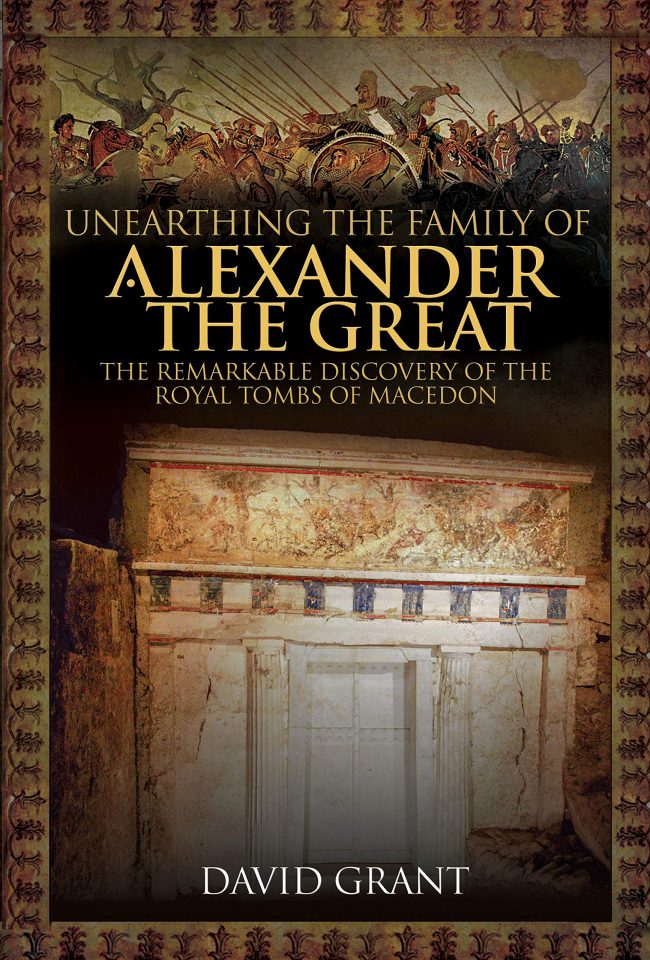
Since the royal tombs were unearthed at Vergina in northern Greece in 1977, there have few historic sites so steeped in controversy. The discovery was dubbed the ‘archaeological find of the century’, but it could have equally been termed the ‘enduring mystery’ from antiquity.
The artefacts within the tombs dated to the middle-to-late 4th century BC and tantalisingly that spanned the reigns of Philip II and his son Alexander the Great.
But a ‘battle of the bones’ has been waged ever since around an ‘unfortunate age symmetry’, surrounding the unique double burial in Tomb II, where a gold ossuary chest held the cremated remains of a male in the main chamber, while female cremated bones lay in the adjacent antechamber.
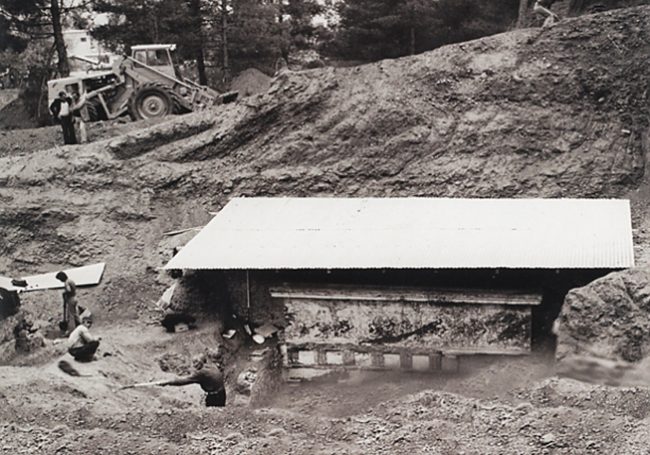
An image of Tomb II being unearthed in 1977.
Who were they?
Initial analysis of the bones suggested the man was 35-55 at death and the woman 20-30 years. Vexingly, that meant they could be Philip II and his final young wife Cleopatra, who was murdered by Alexander’s mother Olympias; equally the skeletal remains could be Philip’s halfwit son Arrhidaeus, who died twenty years later when of similar age and with an equally young bride, Adea.
Both died at the hands, once more, of the vengeful Olympias in an infamous ‘double execution’ in her bid for survival in the post-Alexander world.
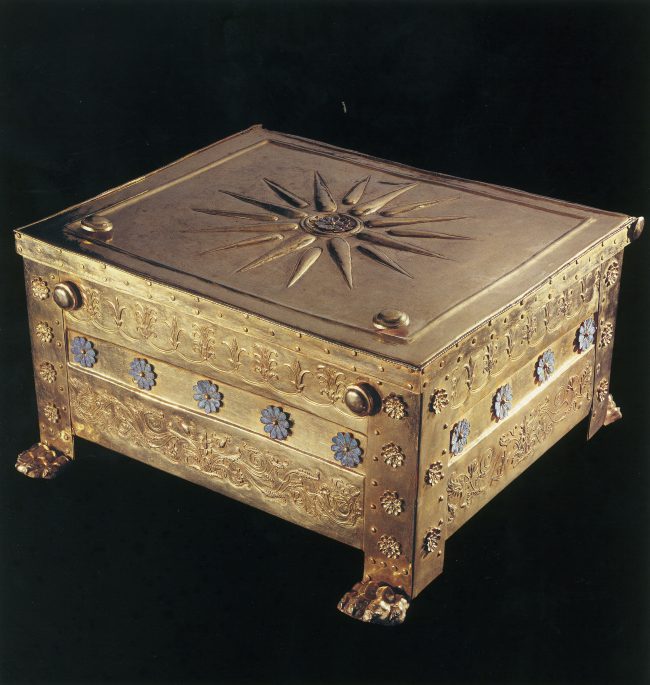
[The gold ossuary chest or ‘larnax’ holding the male bones in the main chamber of Tomb II. Aristotle University of Thessaloniki – Vergina Excavation Archive.
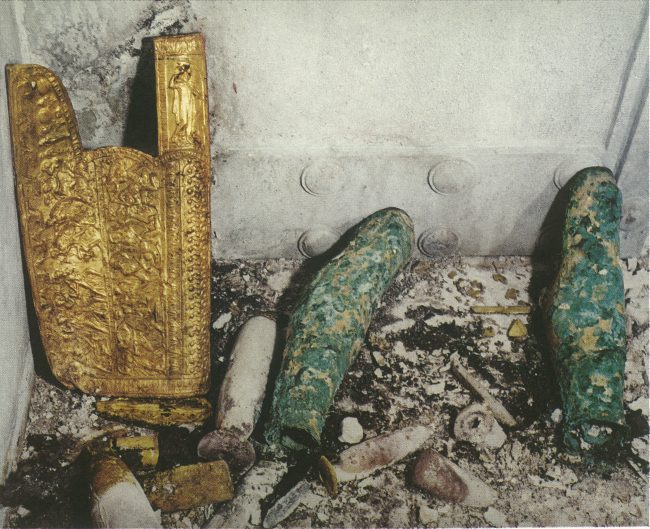
The gold-encased bow-and-arrow quiver or ‘gorytos’ found in the Tomb II antechamber with the female bones, along with gilded bronze greaves. Ekdotike Athinon S.A. Publishers.
The original excavator concluded the woman had ‘Amazonian leanings’, but the curators of the Archaeological Museum of Vergina believe the weapons belonged to the male next door. They still display a curious statement:
‘Weapons were for men what jewels were for women’,
despite the fact that no female accessories lay with the female antechamber bones, apart from a sumptuous diadem and austere Illyrian-styled pin.
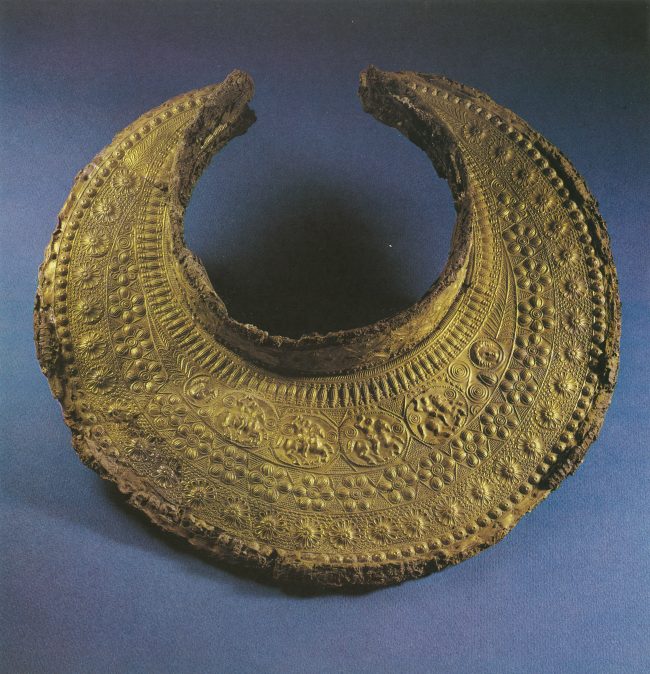
The ornate throat protector or ‘pectoral’ found in the Tomb II antechamber with the female bones. Ekdotike Athinon S.A. Publishers.
Besides the final young wife of Philip II and the teenage bride of his son Arrhidaeus, academics have tried to link the woman’s bones to another of Philip’s wives, the obscure Meda of the Getae tribe of Thrace where queens met with ritual suicide at the death of their king, explaining the Tomb II double burial.
Another candidate is a hypothesised daughter of the Danubian-region Scythian king, Atheas, with whom Philip once planned an alliance; this would account for the Scythian quiver.
But these identifications are problematic: Thracian and Scythian wives were not cremated but throttled or had their throats slit for the honour of being buried with their king, and a hypothetical daughter of King Atheas does not appear in ancient texts.
 Watch Now
Watch NowUnravelling the mystery
The contention that the weapons belonged to the male was recently put to death when an anthropological team found a wound on the woman’s shinbone which proved beyond doubt that the weapons and armour were hers.
The trauma to her tibia had caused the shortening of her left leg, and one of the gilded greaves in her chamber was 3.5-cm shorter and also narrower than the other: it had obviously been custom sized to fit and hide her deformity.
In another ‘eureka moment’, their analysis of her never-before-seen pubic bones, which are most reliable age markers, put an end to more of the identity theories when she was more accurately aged at 32 +/- 2 years.
This ruled out Philip’s older brides and his final young wife Cleopatra, and it significantly excluded Arrhidaeus and his teenage wife Adea from Tomb II for good.
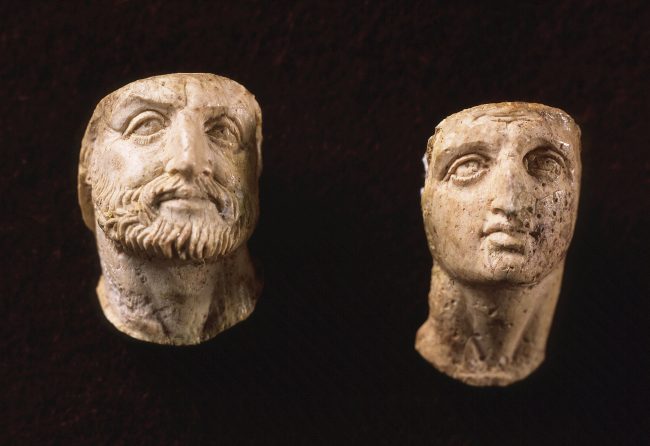
Small carved ivory heads found in Tomb II and thought to be likeness of Philip II and his son Alexander the Great. Grant, 2019.
There does not need to be a Scythian bride to explain a Scythian weapon however. The exquisite gold artefacts found in Scythian graves are, in fact, of Greek workmanship, most likely from Panticapaeum in modern Crimea.
But there was a thriving metalworking industry in Macedon in Philip’s day when weapons and armour were being produced. The local production of export items for Scythian warlords in this time of expanded diplomacy with Scythian tribes means the ‘mystery Amazon of Macedon’ might have been born rather closer to home.
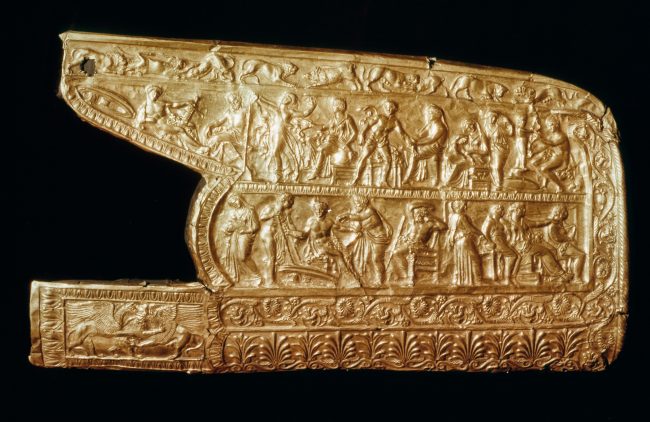
Gold ‘gorytos’ found at Chertomylk, Ukraine; the overall pattern and layout is remarkably similar to the Vergina Tomb II example. Hermitage Museum.
Therefore, a strong case can be put forward for another candidate as the occupant of Tomb II: Cynnane, an overlooked, remarkable daughter of Philip II.
Who was Cynnane?
When Alexander the Great came to the throne after Philip’s assassination in 336 BC, he executed Cynnane’s dangerously popular husband Amyntas Perdicca, Philip’s nephew. But Alexander soon paired Cynnane in a political marriage to Langarus, a loyal warlord to the north.
Langarus died before the marriage was consummated, leaving Cynnane to raise her daughter by Amyntas Perdicca, who she ‘schooled in the arts of war’. The daughter was named Adea.
Soon after Alexander the Great died in Babylon in June 323 BC, Cynnane crossed to Asia with Adea against the wishes of the state regent, Antipater, determined to launch her into the developing game of thrones.
 Listen Now
Listen NowPerdiccas, Alexander’s former second-in-command in Asia, was just as determined to prevent the rogue royal women from the deadly politicking and sent troops under the command of his brother to intercept them.
Cynnane was run through in the resulting skirmish. Indignant at seeing a daughter of Philip murdered before their eyes, the soldiers demanded the teenage Adea be duly presented to the new co-king, Arrhidaeus.
Philip’s pugnacious granddaughter was now married to Philip’s halfwit son, and Adea was epitheted ‘Eurydice’, the regal name of the Argead queens. Both were eventually escorted back to Macedon by the aged regent, but not before the teenage Adea stirred the army to mutiny.
Travelling with them were surely her mother’s hastily cremated bones, as was the custom for the noteworthy who had fallen in battle.
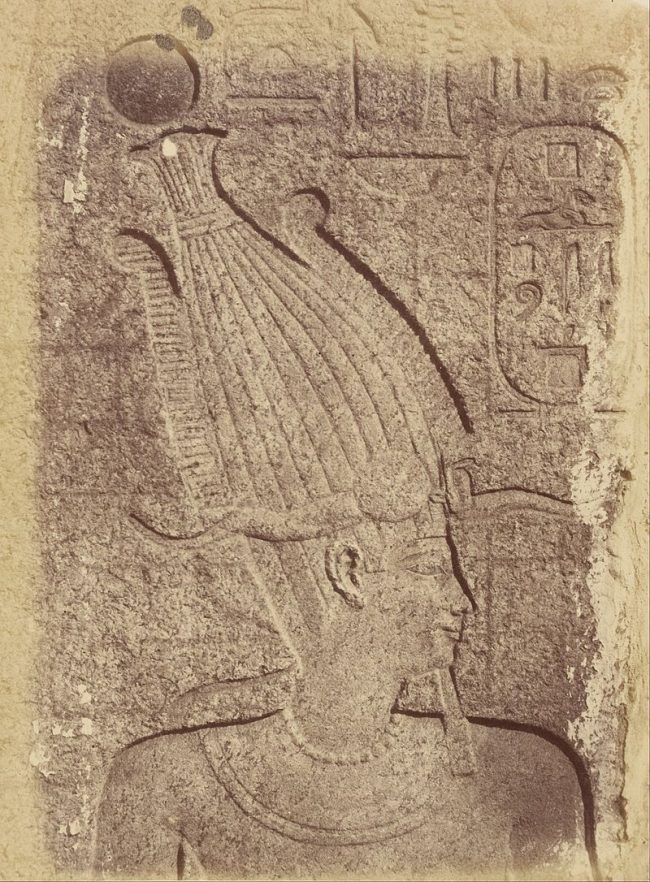
Philip III ‘Arrhidaeus’ as pharaoh on a relief in Karnak.
Warrior women
Following Adea’s capture by Olympias in the ‘first war of women’, as the confrontation of 317 BC was called, she and her halfwit husband were given a rather interesting ultimatum: forced suicide by hemlock, sword or rope.
One tradition tells us the defiant Adea strangled herself with her own girdle, while the hapless Arrhidaeus was put to the Thracian dagger, after which Olympias would have had their bodies irreverently treated and buried without ceremony.
Adea’s martial training at her mother’s hand had always been a powerful argument that the antechamber weapons and bones in Tomb II were hers.
Although sources state that she and Arrhidaeus were later given burial at Aegae by their former ally Cassander once he wrested control from Olympias, nowhere do we read that they were buried in the same tomb or at the same time.
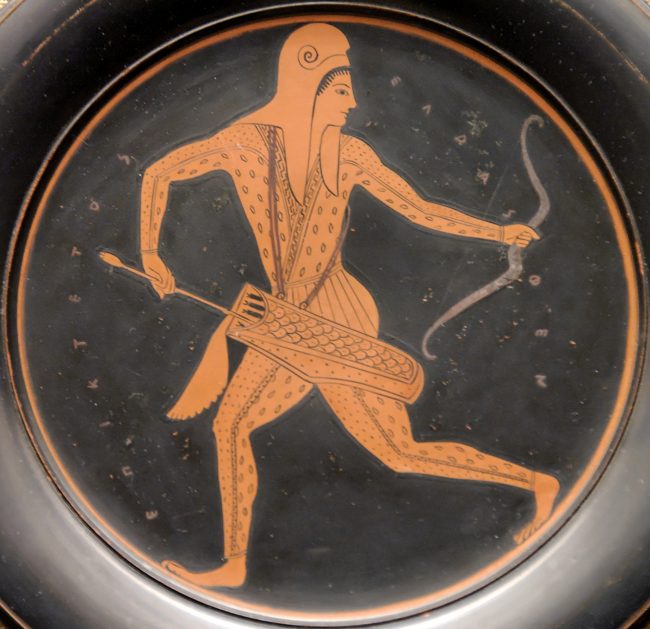
Scythian Archer on an Attic plate dated to 520-500 BC, equipped with the hip-slung ‘gorytos’ and distinctive compound bow. Grant 2019.
But Cynnane was also buried with ceremony at Aegae, the renowned warrior mother who reportedly slayed an Illyrian queen in single combat in her youth. Cynnane is the only credible option for the Tomb II ‘Amazon.’
Assuming she was born to her Illyrian mother Audata several years after she arrived at Philip’s court ca. 358 BC, Cynnane would fall within the newly confirmed age range of 32 +/- 2 for the female occupant of Tomb II.
Philip II must have been proud of his warlike daughter and what better present than a Scythian quiver for an ‘Amazon’ in the making after the famous Illyrian victory, or even as a wedding present when Philip paired her with his guardianed nephew, who was in fact first in line for the throne.
Atalanta
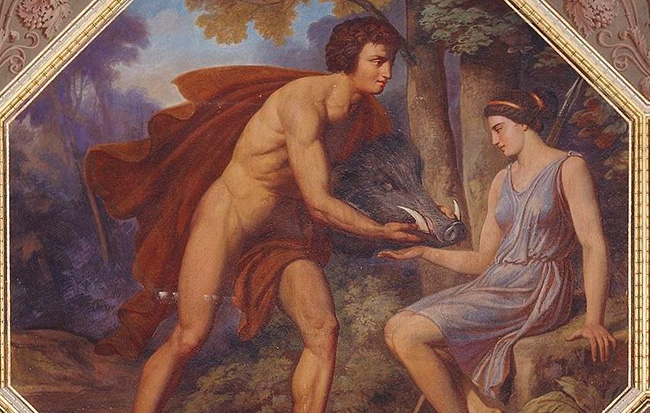
August Theodor Kaselowsky – Meleager presents Atalanta the head of the Calydonian boar August Theodor Kaselowsky, Neues Museum.
But there is another clue that argues for Cynnane: her reluctance to remarry following the death of Langarus. In this respect, Cynnane was presenting herself as something of an ‘Atalanta’, the virgin huntress of Greek myth who was loath to wed.
In ancient Greek art Atalanta was depicted as a Scythian, no less, in gender obscuring britches, high boots, geometrically patterned tunic with pointed hat, and equipped with the distinctive quiver and compound bow.
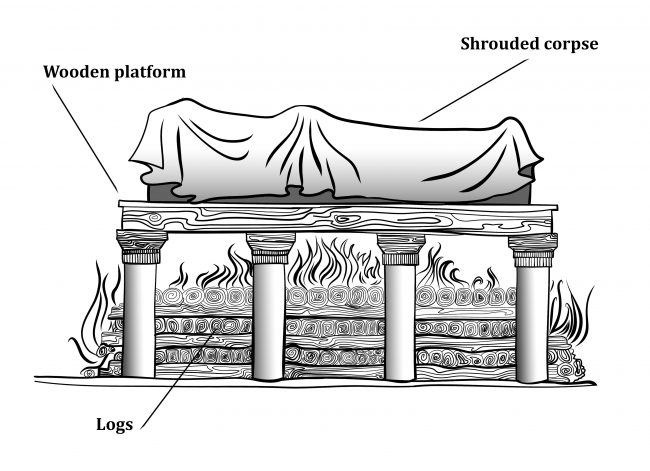
Depiction of a funerary cremation structure at Derveni, nearby Vergina. The body is resting on the top covered in a shroud. Grant, 2019.
Then there is the unspoken elephant in the room: no wife in any source is recorded as being buried interred in a tomb with Philip II when he was assassinated at Aegae in 336 BC, despite the detail we have of his funeral and even the names of the assassin and accomplices.
Indeed, recent analysis of the Tomb II bones makes it clear the man and woman were not cremated together; his bones were washed while hers were not, and the difference in their colour points to different funeral pyre temperatures. The visible powdering of her bones could well have come from long-distance transport in an ossuary.
Further, inconsistencies in the vaulted roofs of the two chambers comprising Tomb II led the excavator to conclude they were constructed, or completed, at different times.
The short-of-resources Cassander, who controlled Macedon from 316 – 297 BC, cost-effectively and yet with self-serving reverence, reunited Philip’s warrior daughter with her father in the as-yet empty antechamber.
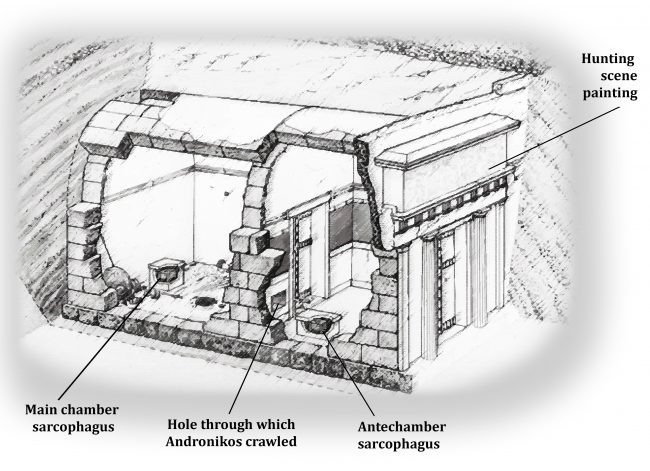
Cross-section of Tomb II showing the main chamber and antechamber. Grant, 2019.
Solving the mystery
The anthropologists and material scientists analysing the bones requested permits for ‘next generation’ forensics – DNA analysis, radio-carbon dating, and stable isotope testing – to finally solve the mystery. Permission was denied in 2016.
The authorities remain reticent for modern science to challenge the current tomb labelling in the Archaeological Museum of Vergina. Politics prevail, and the mystery endures, but not for long.
Unearthing the Family of Alexander the Great, the Remarkable Discovery of the Royal Tombs of Macedon by David Grant was released in October 2019 and is available from Amazon and all major online book retailers. Published by Pen and Sword.



